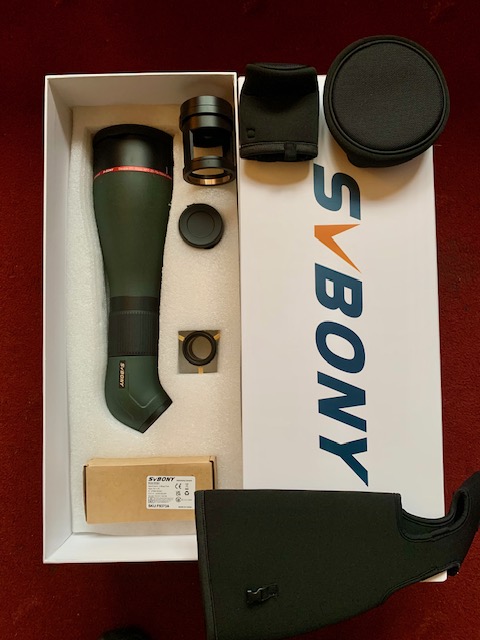
A Work Commenced December 9 2024.
Product: Svbony SA401 25x-75x 100 APO
Country of Manufacture: China
Clear Aperture: 100mm
Armouring: Forest Green Rubber
Magnification Range: 25x-75x
Field of View: 1.77 degrees @ 25x -0.92degrees @ 75x
Focal Length: 556.2mm
Focal Ratio: 5.6
Close Focus: 10m
Focuser: Single Speed, Helical
Coatings: Fully Multicoated
Objective Design: 4-Element Double ED APO
Prism Type: K9 Porro
Exit Pupil: 4mm@ 25x, 1.3mm@ 75x
Ability to use Interchangeable 1.25” Eyepieces:Yes
1.25” Eyepiece Adaptor: Yes
Waterproof: Yes IPX7
Nitrogen Purged: Yes
Weight: 2.9kg
Length: 458mm
Accessories: 1.25” eyepiece adaptor, SC001 imaging camera, scope protective jacket, IPhone adaptor, instruction manual, lens cleaning cloth
Price(UK): £750.00
Over the last few years I’ve watched spotting scopes grow in size. Just a few years back, birders and nature watchers routinely used 60-80mm scopes to study their targets at distance, but recently, a new breed of super big spotters have been released onto the sports optics market, with apertures of 95mm, 100mm and even a 115mm now being routinely employed by enthusiasts who can now enjoy greater light gathering power and higher resolution images. Big spotting scopes employing ordinary crown & flint glass suffer badly from chromatic aberration at higher powers, making them practically unusable at their highest magnification settings(60x or so), necessitating the need for extra low dispersion elements to reduce colour fringing, and increase image sharpness and contrast. But as the aperture increases whilst retaining the typical fast focal ratios(<F/6) required of spotting scopes, chromatic aberration becomes very aggressive indeed, requiring much more attention to detail. Many of these scopes have triplet objectives with one element employing fluorite crystal to stave off colour fringing around high-contrast targets. Fluorite is very expensive though, is very brittle and slightly water soluble, characteristics that reduce its durability in the long run. Another approach is to use two ED elements, similar to that employed by some fast refractor astrographs.
In this review, I wish to showcase a new 4-element, dual ED APO spotting scope by the Hong Kong-based company, Svbony, embodied in their new flagship line of premium spotting scopes, the SA401 series. Two models are available; the smaller 85mm and the 100mm showcased in this review. Furthermore, both retail for well under £1000.
First impressions:

Typical of Svbony, the SA401 100mm APO scope arrived in packaging I can only describe as immaculate. Double boxed, the instrument was sturdily positioned inside its white foam casing, together with various accessories, including a SV 402 1.25” eyepiece adapter, a 2 mega pixel SC001 imaging camera, and a black scope jacket to protect it from the elements. Let’s take a closer look at the instrument.
The magnesium alloy chassis of the SA401 100mm APO spotting scope is overlaid by a thick layer of forest green rubber armouring, with black extremities at the eyepiece and objective ends. The textured rubber single speed helical focuser is also finished in black. An attractive cherry-red ring positioned behind the retractable lens shade displays the essence of the SA401 design, employing two ED elements in its APO designation, and covering a magnification range of 25x to 75x.

The focused cone of light from the 4-element objective is reflected to the zoom eyepiece via a Porro prism using K9 optical glass(the optical equivalent of BK7) which is perfectly suitable for this F/5.6 instrument. In addition, K9 optical glass has a lower dispersion profile than BAK4, which helps a wider range of visible wavelengths to remain tightly focused before being magnified by the eyepiece.

Like their other spotting scopes, a large, round knob is located on the upper right of the chassis just ahead of the helical focuser. Once loosened, the built-in mounting bracket can be smoothly rotated through a full 360 degrees, which enables the user to achieve a comfortable viewing position irrespective of the location of the target.
The interior of the SA401 spotter is very clean and dust-free, as the photo below shows, with nicely machined baffles, and other blackened components to help reduce stray light and maximise image contrast.


Ergonomics:
The SA401 100mm APO 25x-75x tips the scales at 2.9kg, with the extra heft over other 100mm spotting scopes probably attributed to its 4-element objective. It feels really solid in the hand. Fit and finish are fantastic. The helical focuser moves smoothly and precisely allowing the user to bring any object beyond about 10m to a crystal clear focus.
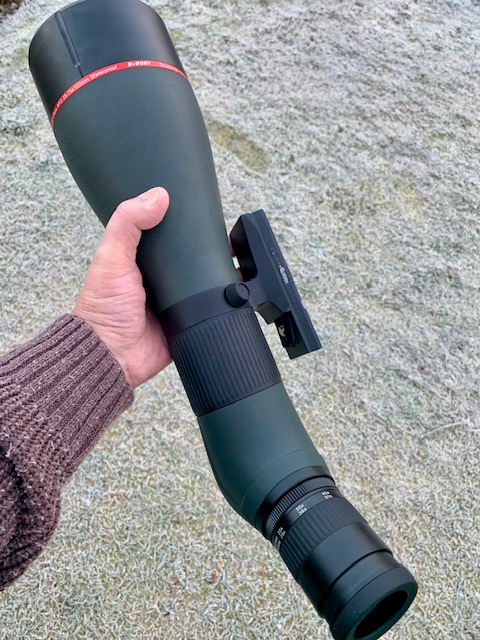
The zoom eyepiece has plenty of eye relief. Testing with glasses on, I was able to access the entire field throughout the full magnification range of the instrument.
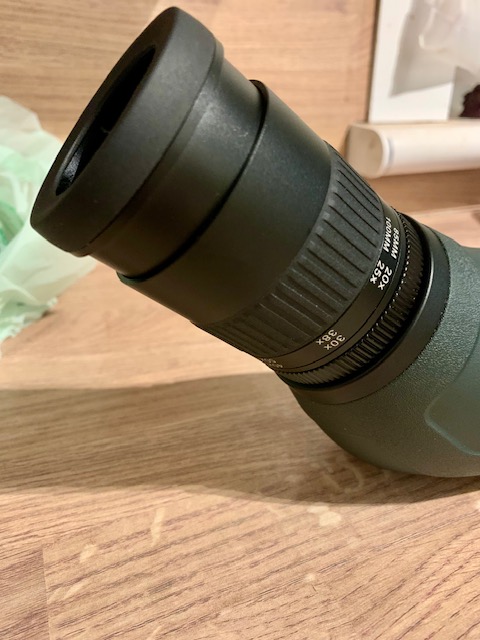
The zoom eyepiece can be removed from the instrument simply by unscrewing it. The user can then insert other eyepieces or the supplied SC001 imaging camera, by means of the SV406 adapter (also supplied), as shown in the photographs below:
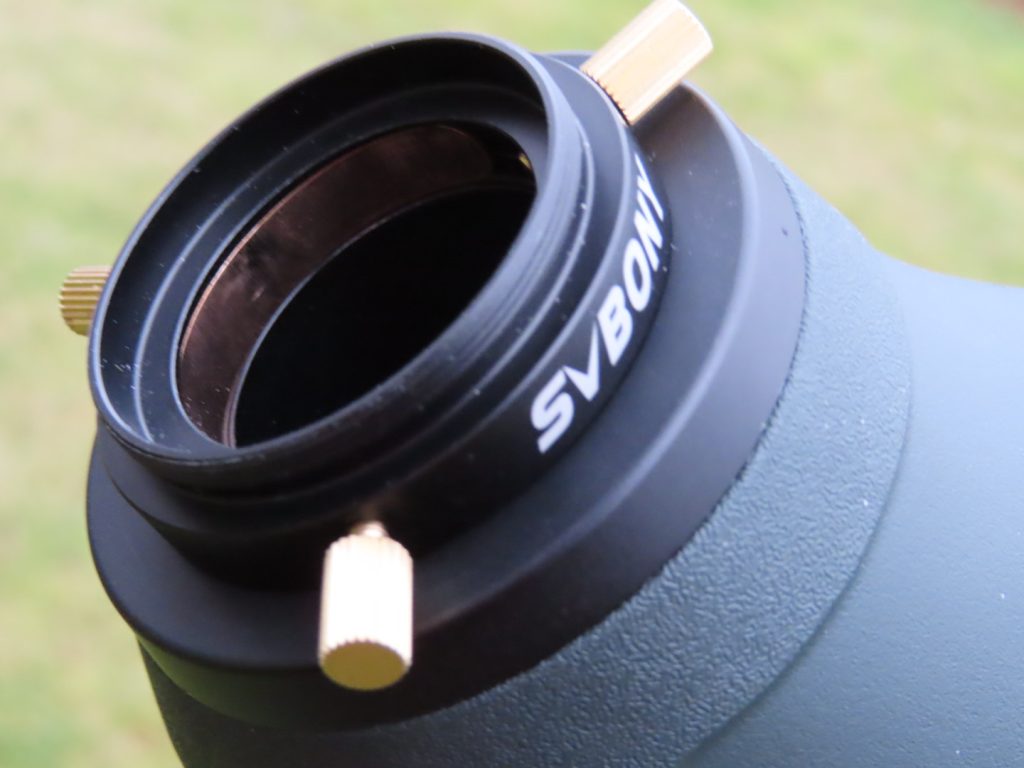
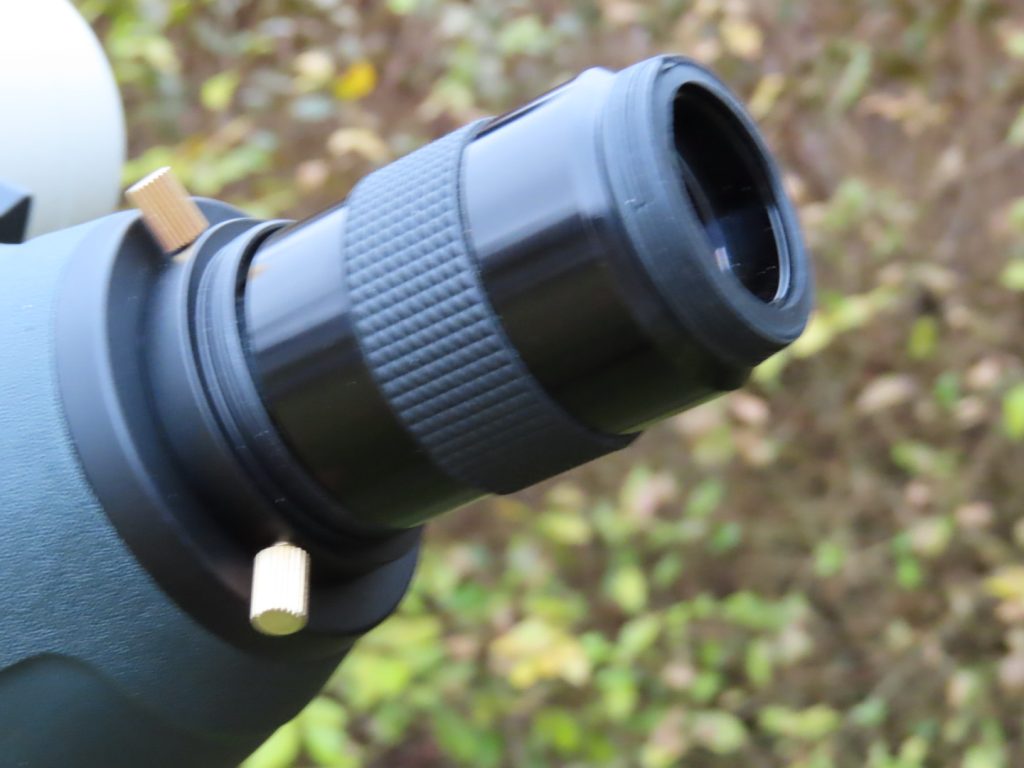
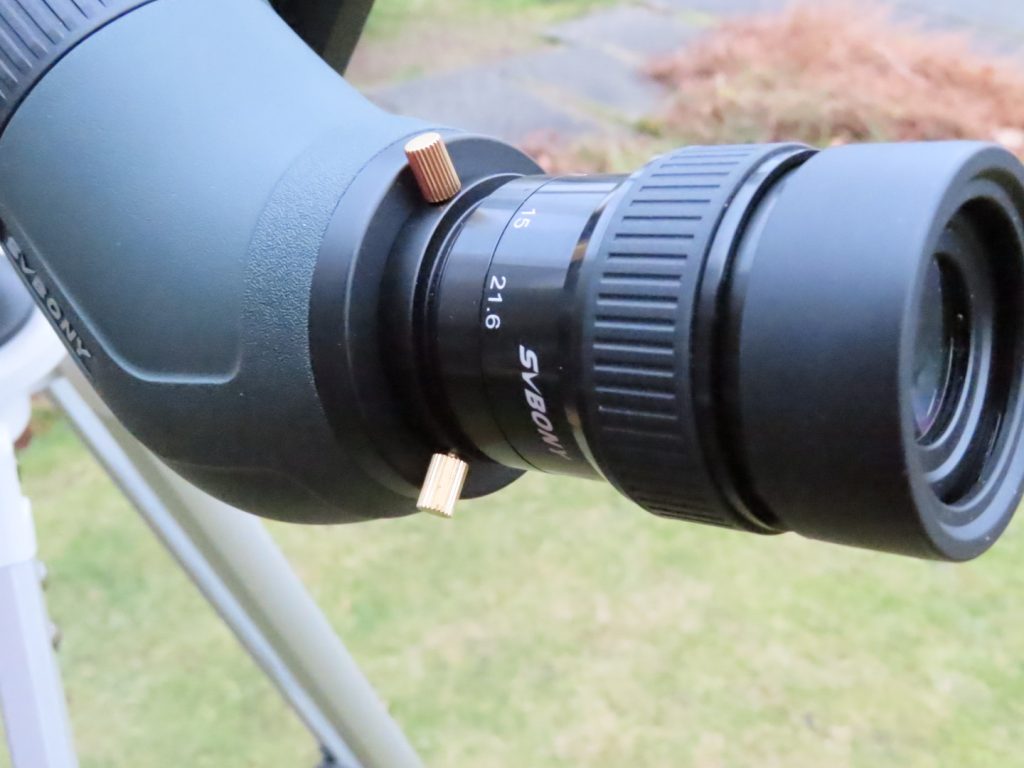
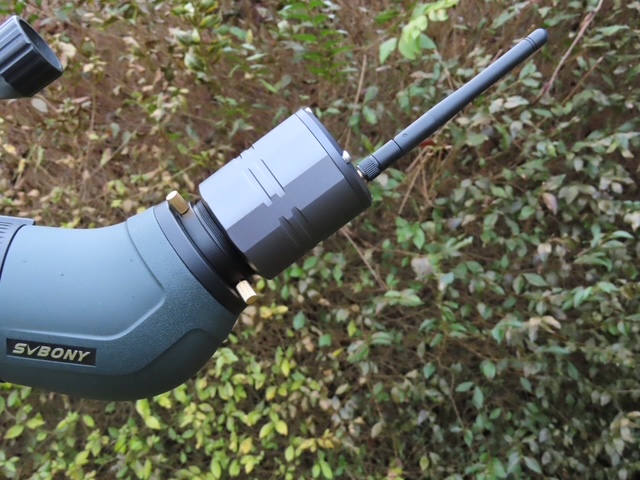
For most of my initial testing, I mounted the SA401 on my trusty Vixen Porta II altazimuth mount via a small dovetail plate seen attached to the instrument in the second photo above. This mount has slow motion controls on both axes, allowing me to quickly centre a target or track it. For more portable work away from my home I elected to use the lighter weight SV402 mount with its fluid panning head. More on this later.
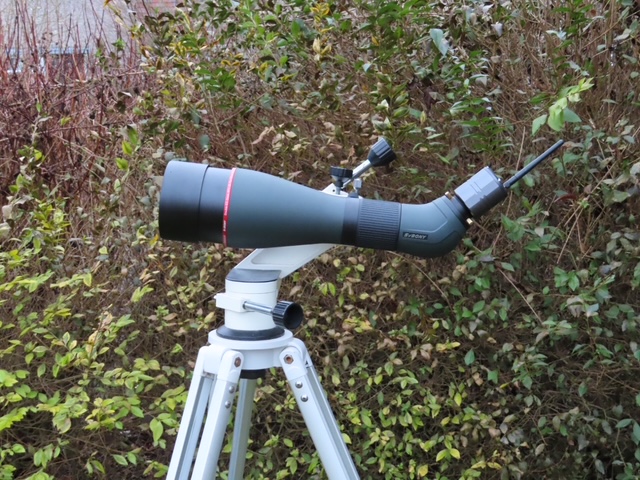
True Aperture Test:
A spotting scope costing this much ought to be operating at is full aperture. Researching other models in the same price range, such as the Celestron M2 Regal 100mm ED, revealed that it was not operating at 100mm but more like 90mm. I set up a simple flashlight test to measure the effective aperture of the SA401 and found it to be exactly 100mm.
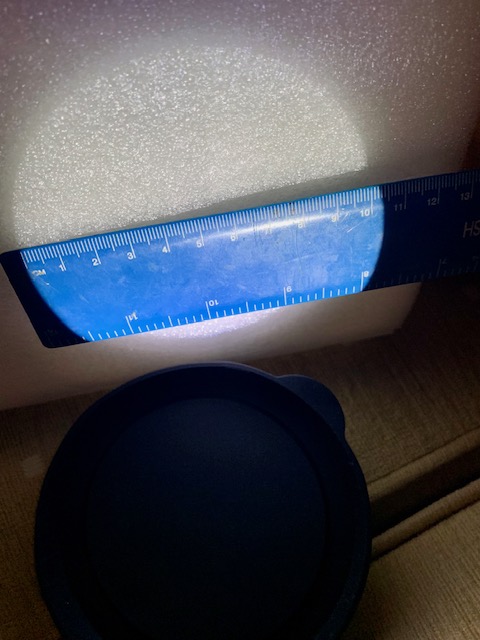
That’s a reassuring result, as the whole point of using a large spotting scope like this is to avail of its additional light gathering power, especially in low light situations.
Bright Light Test: Not all people who buy and play around with spotting scopes will use them for nature studies. Some folk who live in high rise apartments like to get good views of the town or city in which they live, whether by day or by night. A spotting scope showing strong internal reflections from bright city lights would be off putting. To test this, I turned the SA401 on some bright street lights at various distances up to 100 yards away. I’m happy to report that there was very minimal reflections seen and only on the very brightest sources. This would be a good instrument to enjoy cityscapes after dark.
Optical Impressions:
Arriving late in the afternoon on a dull winter’s day, I aimed it at some trees about 100 yards in the distance. Racking the zoom eyepiece throughout its 25x to 75x range, I was able to get a very sharp, crisp and bright image with excellent contrast at all magnifications. Edge-to-edge sharpness appeared excellent in my test unit. Colours were natural: not too warm or cold. The apparent field of view(AFOV) became quite noticeably wider as I moved up in magnification though. Moving back to 25x I felt the field was a little narrower than I expected based on my experience with other zoom eyepieces. Looking closely at some branches against a grey sky showed that the instrument displayed very minimal colour fringing at the 75x setting. I could immediately tell this was a noticeable step up in colour correction from the SA405 85mm scope(an ED triplet) I reviewed a couple of years ago. Some of this residual CA was coming from the eyepiece for sure. Over the next few days, I took a series of images with my IPhone just handheld to the eyepiece set at 75x to give the reader an impression of the degree of colour correction evident in the scope in various lighting conditions, drawing on the excellent work of Roger Vine who reviewed the Zeiss Harpia 95mm spotting scope. Let’s take a closer look:
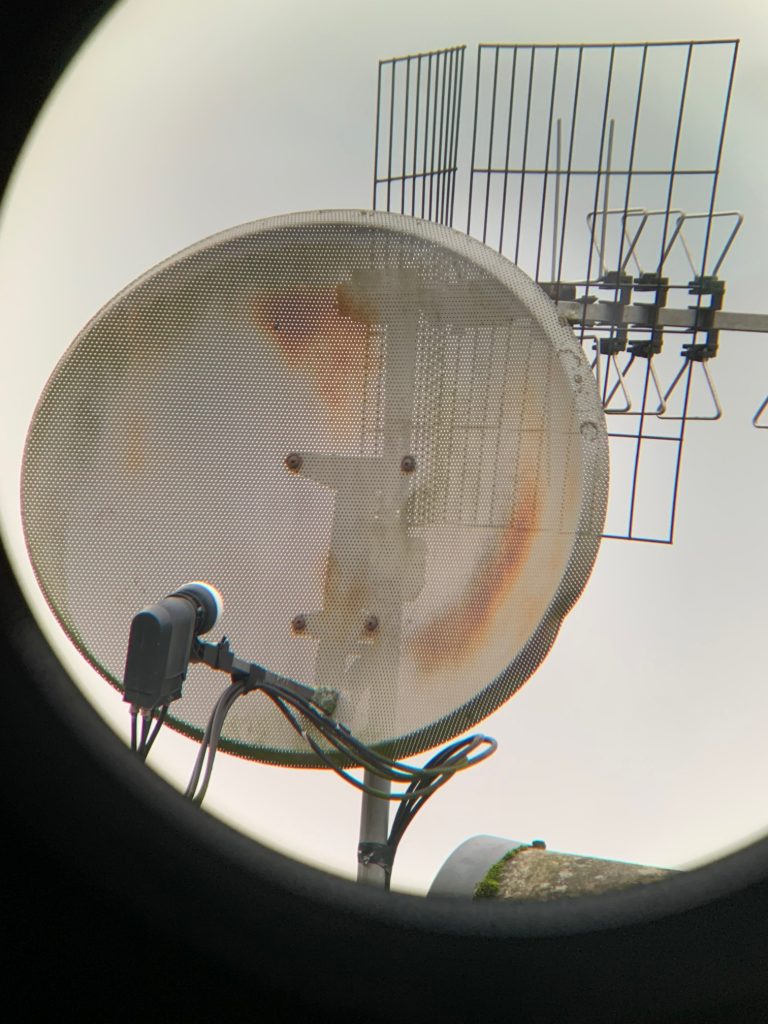
The above image zoomed in to look at the aerial:
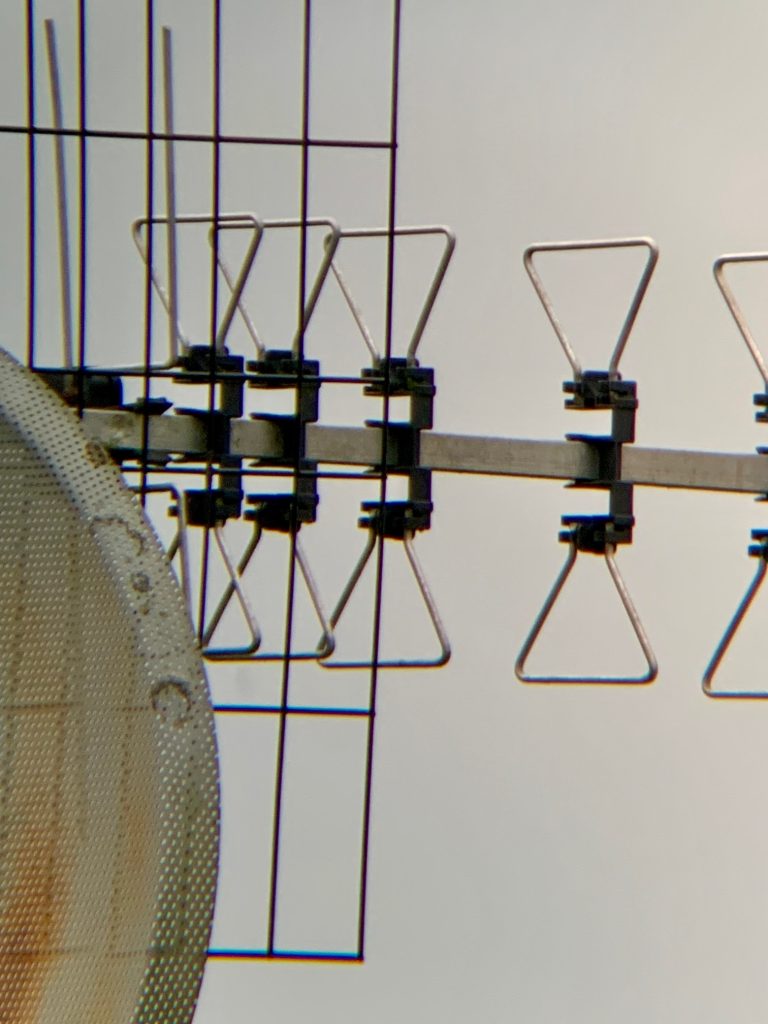
And tree branches against a dull grey sky:

In the next two images, I present a view of a Rook perched high in a tree with the winter Sun behind me, followed by another Rook against a dull grey sky:
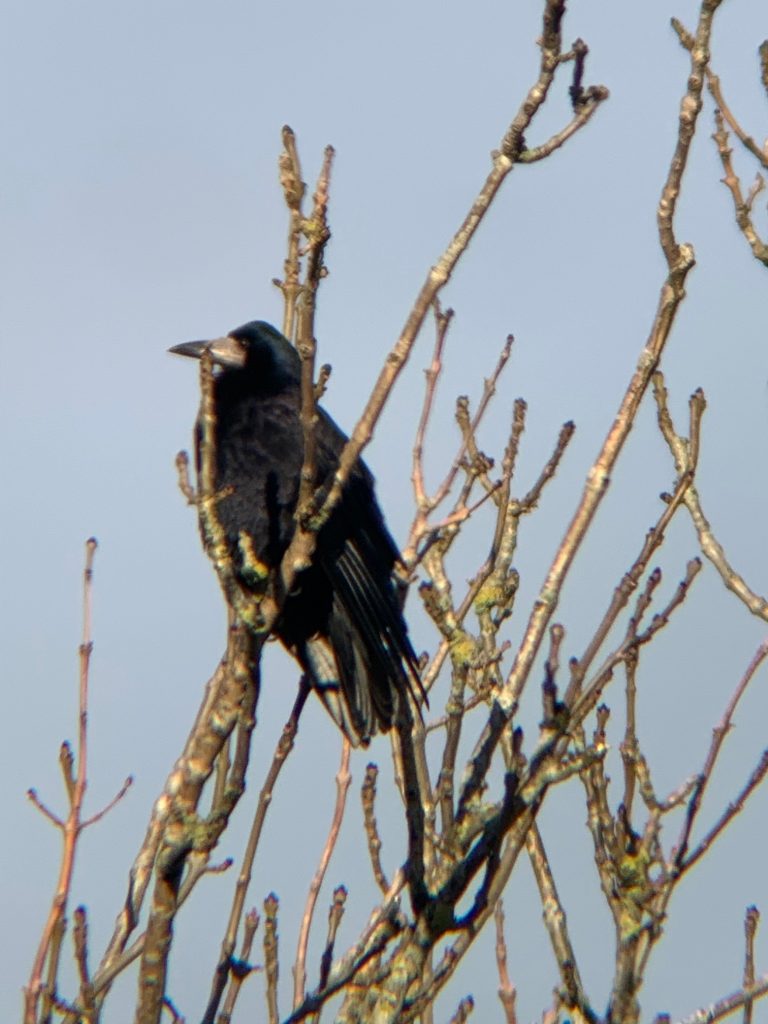
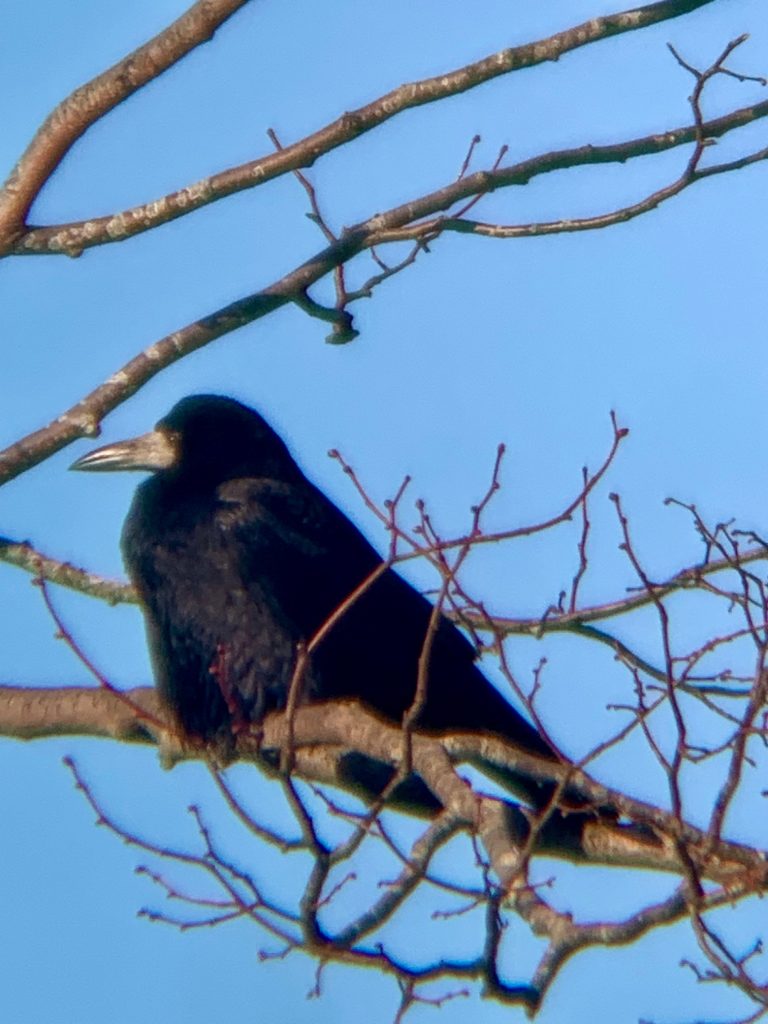
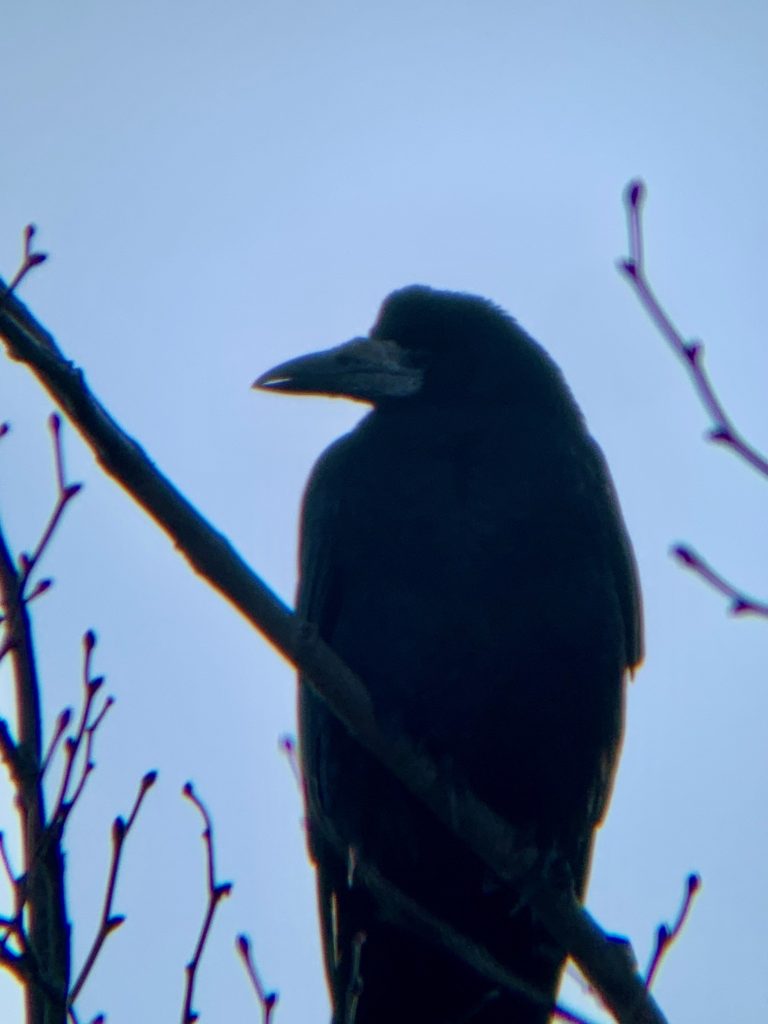
In one final test for chromatic aberration, I inserted the SC001 digital imaging camera into the optical train and pointed the properly acclimated scope at a waxing gibbous Moon. Here is a single shot I obtained:
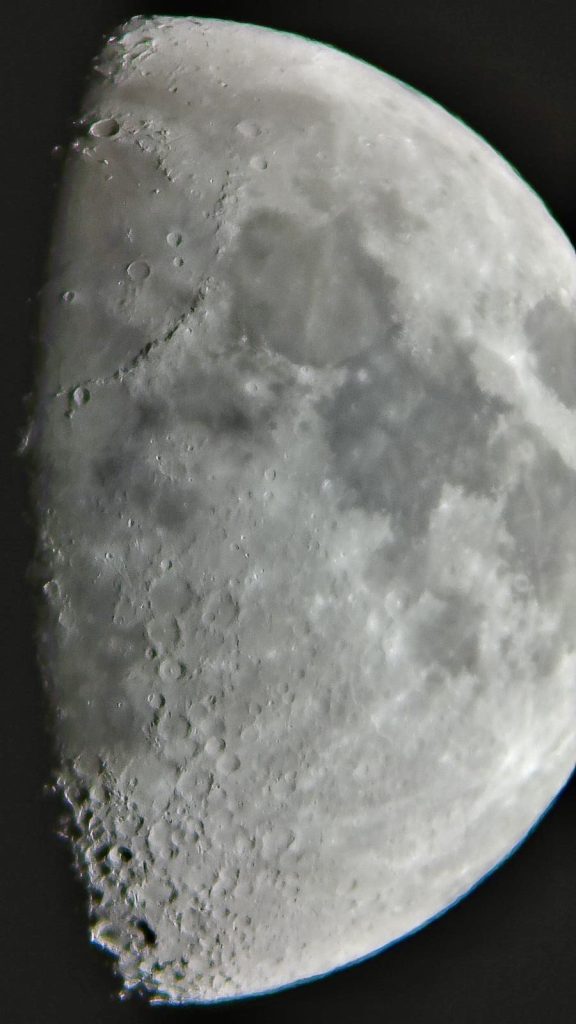
Commentary on the Images
I hope the reader who carefully examines the images, which have not been processed in any significant way, will conclude, as I have, that colour fringing in the SA401 100mm spotting scope is extremely low or even insignificant. This residual secondary spectrum could easily be removed post processing of course. Reflecting on Mr Vine’s comments on Zeiss’ flagship spotting scope and his posted images, I would agree that even this very sophisticated (with a price tag to match!), shows significant lateral colour, even more I’d say, than the SA401 tested here. Vine also makes the point that observing a jet black Crow against a uniform grey background sky will show colour fringing even on a scope as sophisticated as the Zeiss Harpia. The reason is that high-end spotting scopes have far more complicated optical designs than regular ‘apochromatic’ astronomical refractors, and it shows when eliminating the last vestige of false colour in the image. What’s more, optical testing of high-end spotting scopes show they fall below that of high quality astronomical refractors, but work fine within the magnification range over which they were designed.
Vine likens the view through the Harpia to a Televue 85: a simple ED doublet, at the same magnification. I would add that this is very likely to be the case on any high end spotting scope advertised as ‘APO.’ If you want better apochromatic performance at powers beyond 60x, you’re going to have to move to a moderate focal length (>F/6) astronomical triplet ED refractor and put up with the world the wrong way round(read left-right reversed).
The reader will also take note of the edge performance of the SA401 spotting scope, as evidenced by the image of the trees, showing the sharpness right up to the field stops. That’s an impressive result, in my opinion, and quite in keeping with my initial visual report. The SA401 does not utilise a field flattener but its excellent edge sharpness is probably down to its smaller true field of view(1.77 degrees).
Further Optical Tests:
To further substantiate these comments I set up my Skywatcher Evostar ED 80- an 80mm F/7.5 FPL53 ED doublet APO using Schott optical glass – with the SA401 spotting scope to compare their colour correction on a high contrast target.The little Evostar is a proven standard in apochromatic performance. It shows only a trace of false colour on the highest contrast targets.

I took a handheld image with my IPhone at 75x on a telephone wire about 30 yards in dull, overcast conditions, at about 30m in the distance. Here are the results. The first image is taken through the Evostar 80ED and the second was shot with the SA401. The sky brightened just a little while taking the Evostar 80 ED image.


You can see that the colour correction is very comparable in both instruments. The decently slow F ratio of the ED doublet ensures a well corrected optic. Visually, I felt the Evostar ED had slightly better contrast and colour correction compared with the bigger SA401, though I did notice that the image was significantly brighter in the latter. The reader will note the left-right reversed image from the Evostar.
Under the Stars:

The collimation of the SA401 100mm spotting scope was perfect. I used the SC001 imager to get an image of the intra-focal Fraunhofer diffraction pattern of the bright star Capella, with limited results, as it’s not designed to take high resolution astronomical images. Nevertheless, you can see that the pattern is perfectly round, indicative of the proper squaring on of all the components in the optical train. A few of the outer diffraction rings are also in evidence:
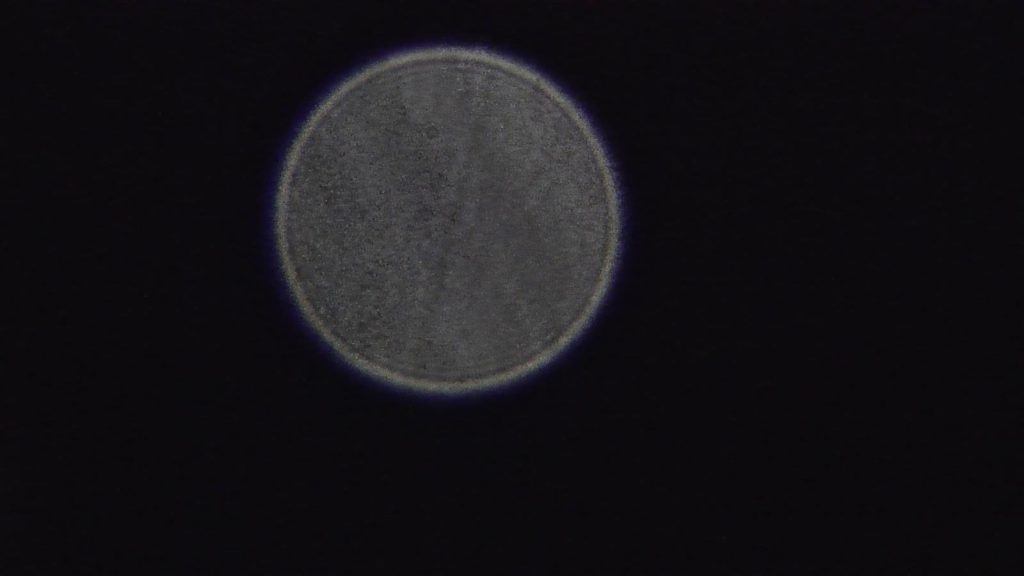
With three outer planets on the sky at the time of writing I was keen to see how they appeared in the SA401. Saturn showed a beautiful yellow globe with the rings seen almost edge on at 75x. Mighty Jupiter, now exceptionally well positioned in the night sky at my northerly latitude, was magnificent at 75x. The creamy-white oblate sphere was tack sharp with no false colour, the planet crisscrossed by numerous belts and zones. I enjoyed several satellite eclipses over a period of weeks and I was impressed to be able to see the famous Great Red Spot at this relatively low power. Fiery Red Mars rising later in the constellation of Cancer, showed a tiny, crisp orange disk with no chromatic aberration that I could make out. The views I enjoyed at 75x inspired me to crank up the power to get a closer look.
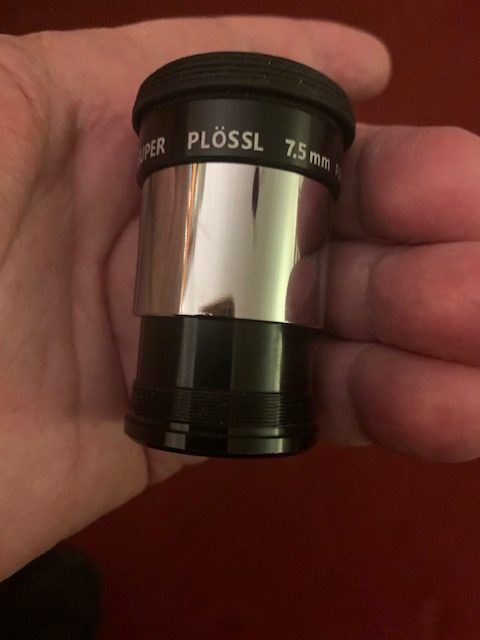
As mentioned earlier, the SA401 is capable of accepting 1.25” eyepieces, but not all those I tested were able to come to focus at infinity. While simple short focal length Plossls and orthoscopics worked superbly, one of my absolute favourites, like the exceptional Svbony SV215 3-8mm planetary zoom, did not focus at infinity. By unscrewing the lenses from my 2x and 3x Barlow lenses and placing them ahead of these eyepieces, I could boost the magnification further(up to 200x). Another winning combination was inserting these amplifying lenses ahead of the SV191 7.2-21.6mm zoom to give a useful range of magnifications.
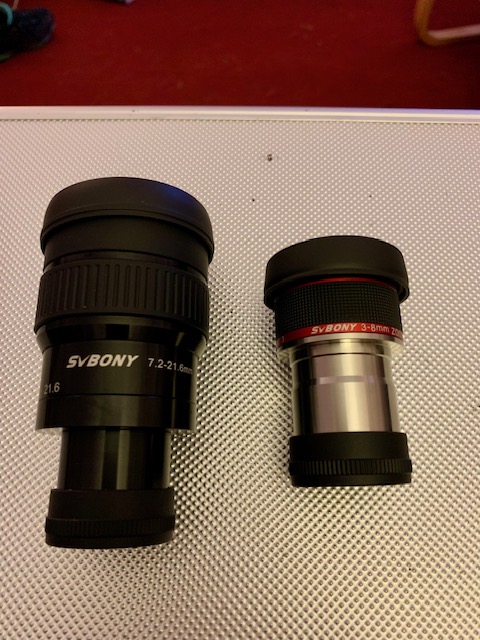
Perhaps the best way to glean higher powers from the SA401
is to use Svbony’s Gold Series 6mm wide angle eyepiece with its 66 degree AFOV. It sports very generous eye relief – far more than any short focal length Plossl – generating a power of 93x. What’s more, when a 1.6x Barlow is screwed into the nose of this eyepiece, it delivers a power of 148x – plenty high enough for most any application. And yes, the configuration focuses at infinity!

The 6mm Gold Series also has a large and comfortable eye lens for easy eye placement.
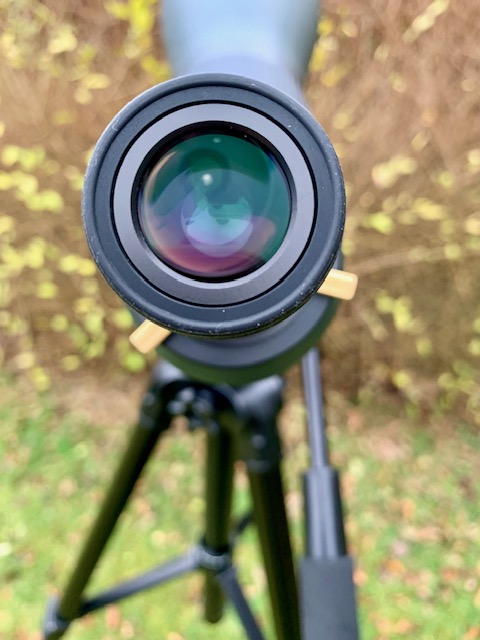
Taking advantage of exceptional seeing conditions during the second week of December, when a huge high-pressure bubble over Scotland brought calm but gloriously clear sub-zero temperatures, I turned the instrument on these planets once again. Saturn at 150x looked even more magnificent with its largest satellite, Titan, easy to see. Jupiter showed very nice details at 139x – swirls, spots and festoons, racing their way across the planet as it rotated. The instrument stubbornly refused to show any significant secondary spectrum. On one night, I watched as a Galilean satellite appear as a tiny ‘pimple’ on the limb of the planet, growing larger as it rounded mighty Jove, before ‘pinching off’ to join the other moons in orbit. Wonderful! In the wee small hours of a freezing December night, I cranked the magnification up to 180x to take a closer look at Mars. Though the ruddy Martian disk remained small, I was clearly able to make out the Syrtis Major and a prominent northern polar ice cap. A word of advice would come in handy here. The complex optical design of this spotting scope needs some time to acclimate. Taking it out on a whim from a warm indoor environment to observe the planets at these high powers will likely disappoint. I recommend a good hour of prior acclimation to get the best out of this telescope.
The SA401 100mm spotting scope shows stars as beautiful pinpoints with no chromatic halos around the brightest luminaries. While I’ve been blown away with the views served up by a high-quality 15 x 70 binocular, the view of the Pleiades through the SA401 on a dark, moonless night, was quite simply a show stopper! The beautiful asterism filled the low-power field at 25x, with its constituent blue- white stars shining gloriously. I could even make out some hints of the reflection nebula around Merope. And while my main telescopes are all optimised Newtonians, the view through the SA401 brought back fond memories from my small refractor days, with its crisp, high-contrast views.
As a double star specialist, I was keen to see how the SA401 fared on a variety of these targets. Choosing a power of about 150x, I managed excellent splits of Castor A & B, Epsilon 1 & 2 Lyrae, Polaris A & B, and the spectacular triple system, Beta Monocerotis. Rigel proved more elusive, but on a night of very good seeing, I managed a convincing sighting of its faint close-in companion. I could have visited many more but star hopping is a lot more challenging without a finder scope. Sighting along the side of the tube just has its limits!
All in all, the SA401 proved to be an impressive performer under the stars. It would really benefit from having a simple finder though especially for astronomical applications or when using high powers during daylight. Perhaps a Rigel Quikfinder or some such?
Field Craft:
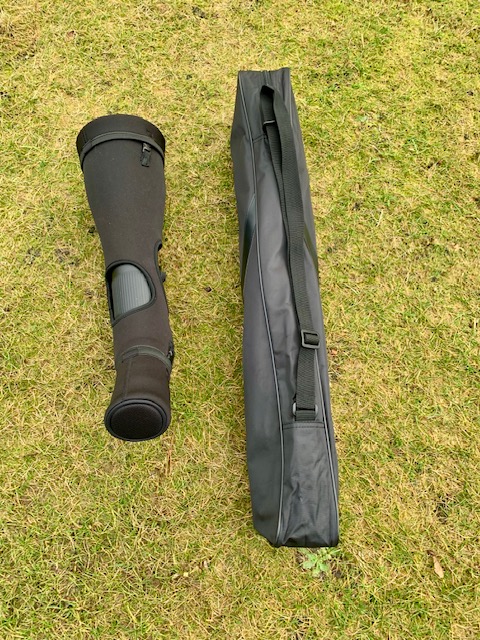
A large, high-quality spotting scope like the SA401 deserves a decent mount for mobile terrestrial observations. I was looking for a tripod light enough to carry on foot, but strong enough to accommodate the sizeable weight of this big 100mm instrument. I took a punt on Svbony’s SA402 tripod which has a number of attractive features, including its light weight(2.2 kilos) a hydraulic gimbal and large pan handle for easy manoeuvres both in azimuth and altitude.
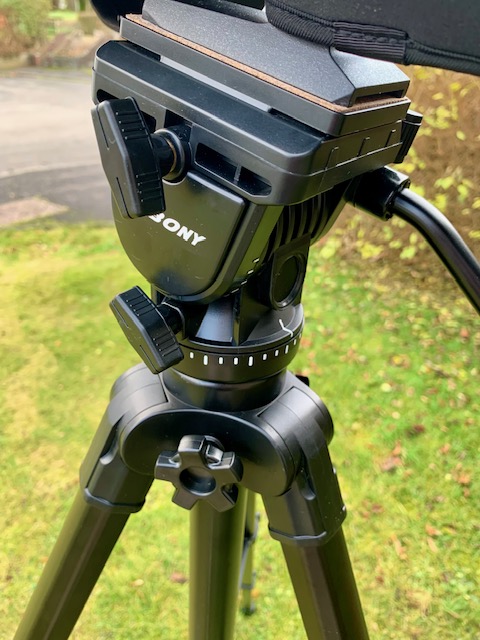
It comes with a quick-release bracket for rapid and easy mounting and dismounting of the spotting scope. The strong, extendable 30mm-diameter aluminium legs reach a height of about 65 inches: perfect for my standing observations and imaging applications. Fully retracted, it stands just 27 inches above the level ground.
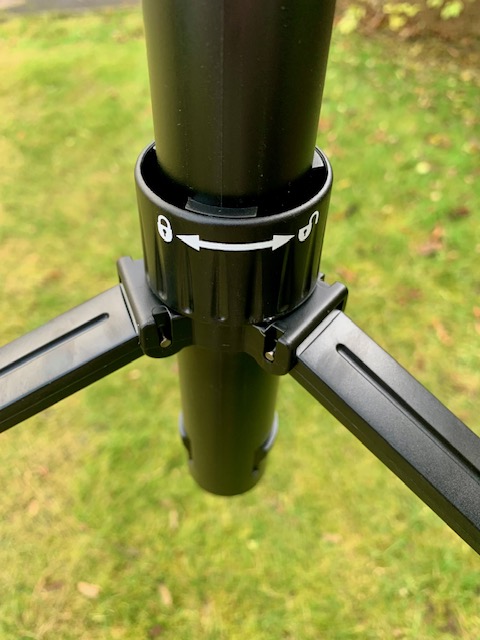
The sturdy head can support weights up to 6 kilos. One other nice feature of the SA402 mount is the ability to lock the leg spreaders in place. The base of the legs also have decent rubber pads to add extra grip. Though I would not recommend the SA402 for astronomical observations, owing to its lack of slow motion, fine controls, it proved ideal for using the scope during the day.
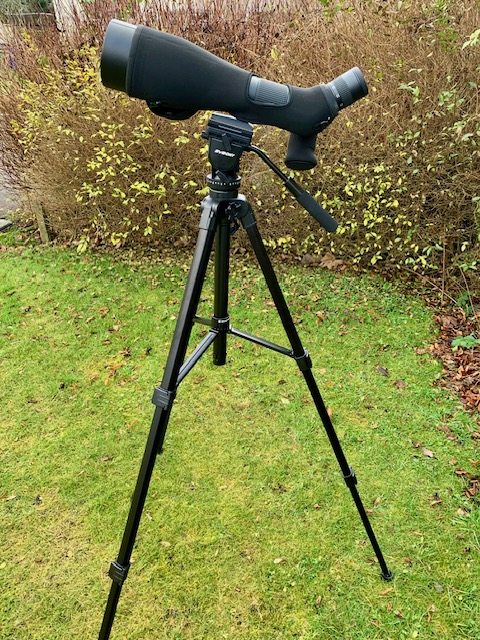
The black neoprene jacket fits snugly around the telescope and provides extra protection of the optics against the elements.

Placing the scope on the SV402 mount, it made sense to swap out the zoom eyepiece on the SA401 for the SV191 7.2-21.6mm using the supplied adapter as the same adapter was used to mount the SC001 imager. Carrying the entire set up on my shoulders, I walked a half a mile up to my local pond to capture some images of the wildlife out on the water.

All the images were shot on a dull,overcast mid-January day with some light rain showers complicating matters. Nevertheless, the SA401 is weather sealed against the elements and coped well under the circumstances. For scale, all the subjects captured were located at about 100m in the distance. The images all underwent some basic IPhone processing after capture.
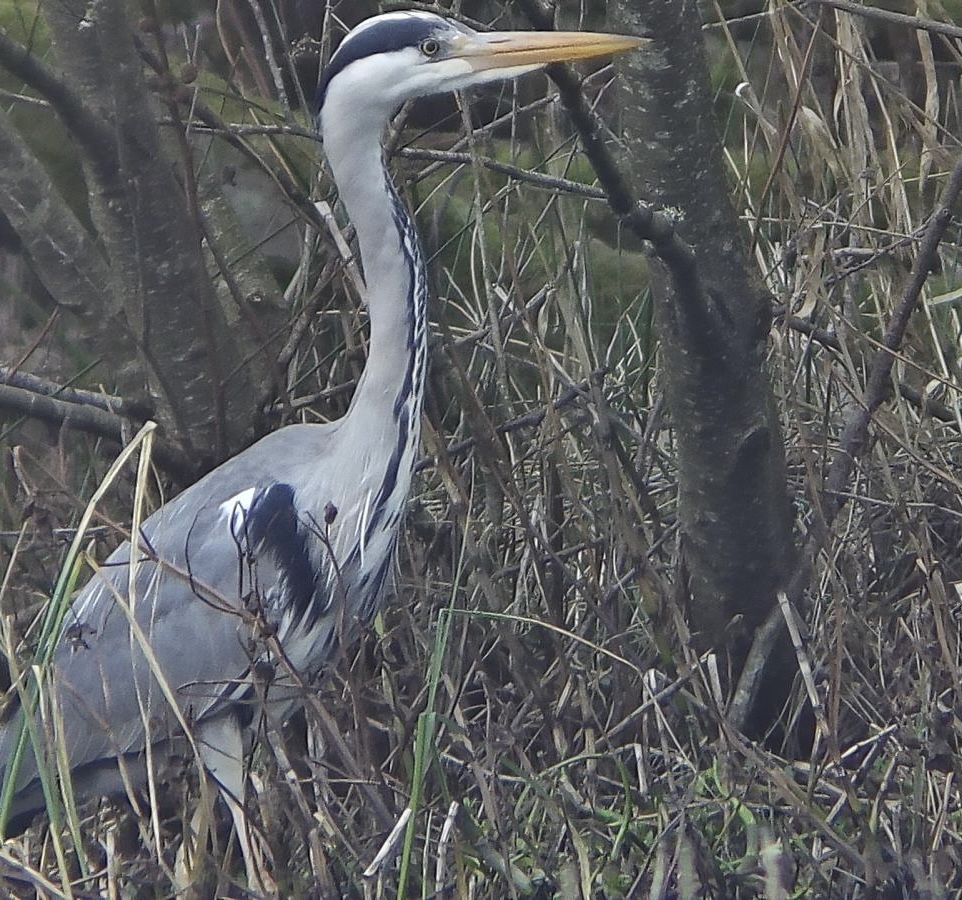
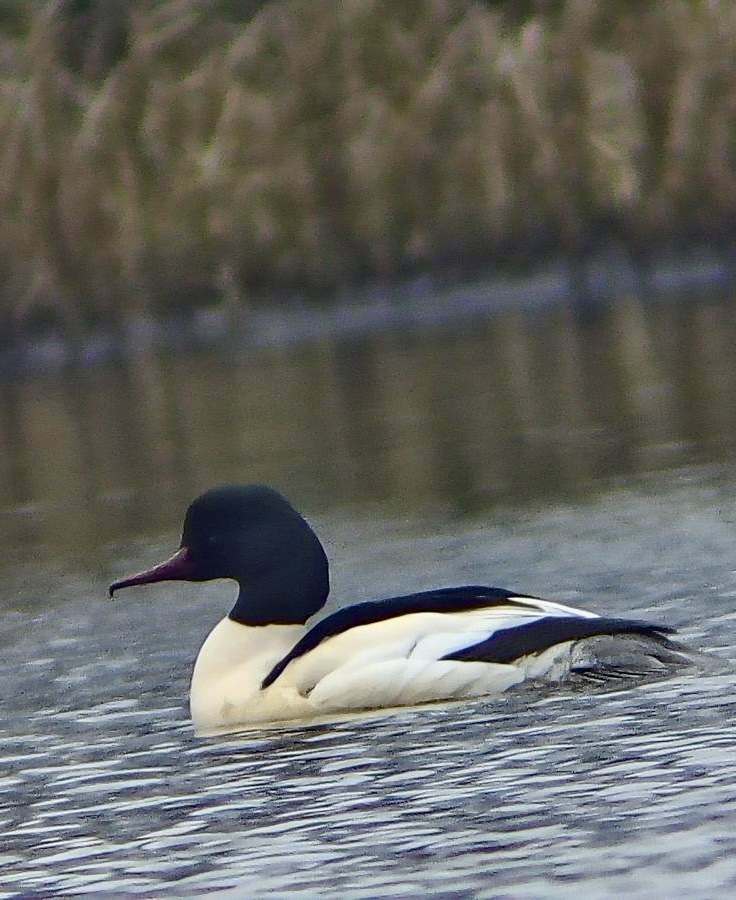
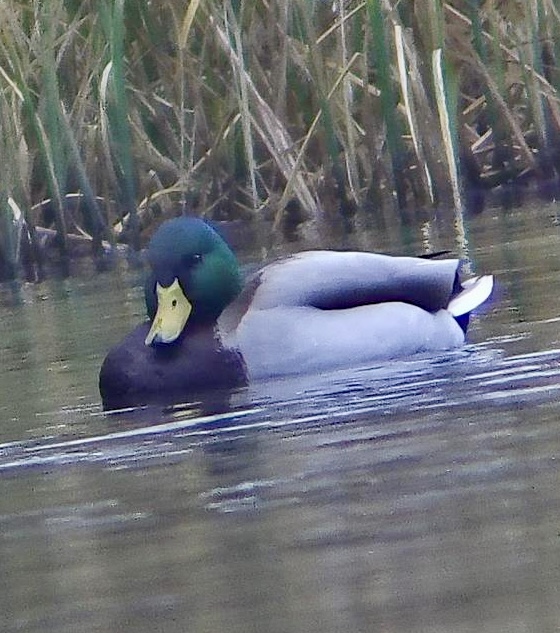
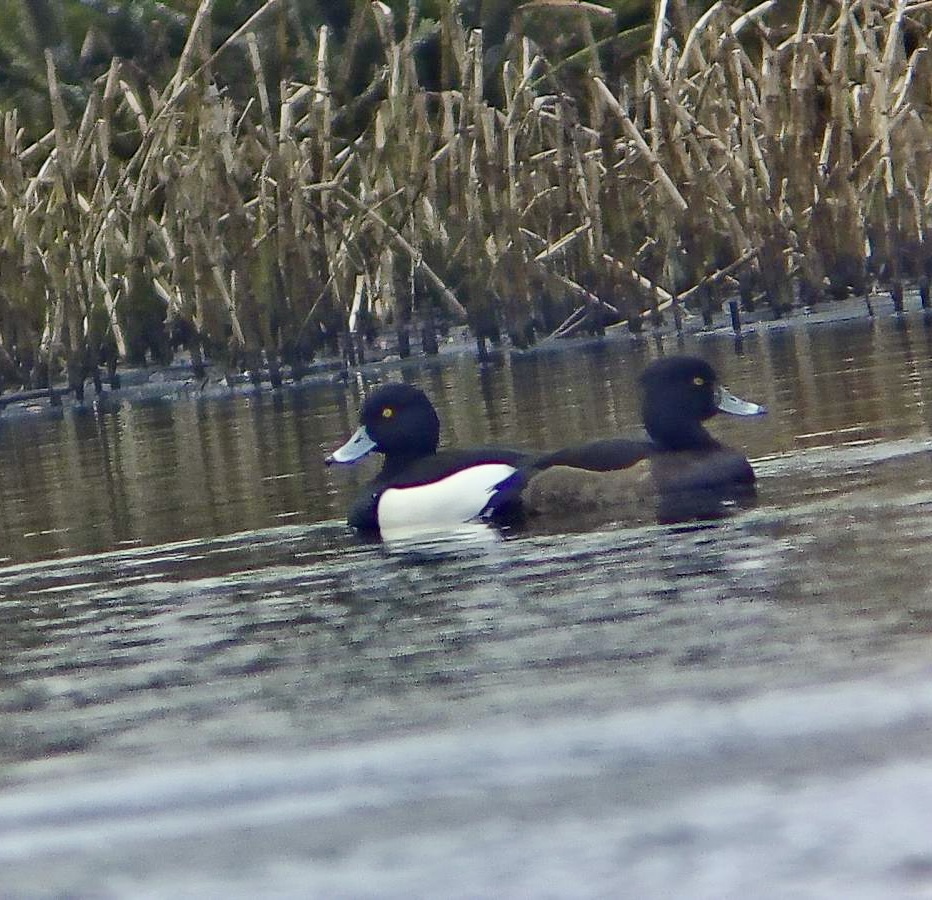
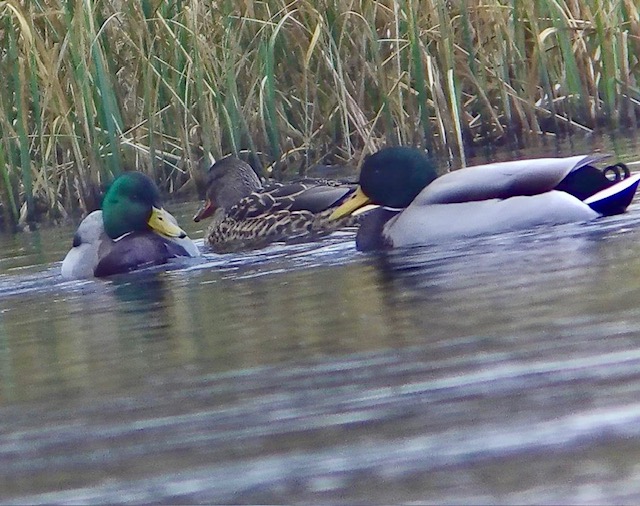
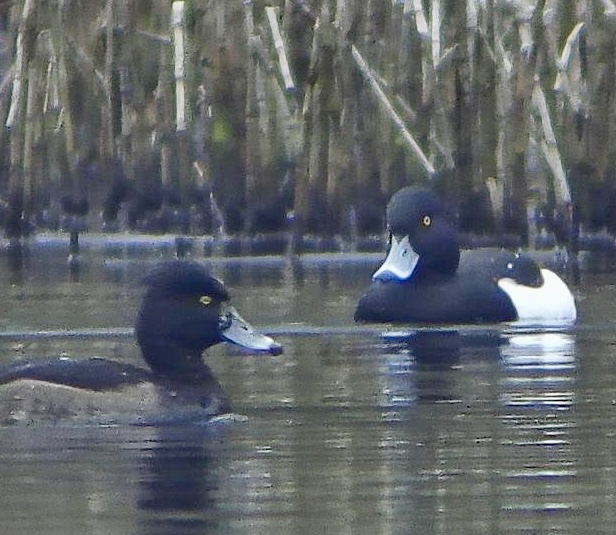

Conclusions & Recommendations:

The SA401 25-75x 100mm APO is a powerful and versatile spotting scope with excellent, pin sharp optics and robust ergonomics. As well as its optimised daylight performance, it can also be used to explore the night sky. Chromatic aberration is very low and edge-of-field performance impressive. To get anything better, I suspect you’d have to spend at least twice as much again. Svbony offer these scopes in a variety of packages, with the tripod, SC001 imager, or DSLR adapter depending on your requirements.
Finally, it’ll pay the reader to have a look at two other reviews I found on the SA401 for comparison:
Review A: Taken Directly from Amazon
This is my first spotting scope outside the alpha scopes from Zeiss, Swarovski and Leica, I have always bought secondhand because I couldn’t afford them new and wanting a 100mm aperture there was no Way I could afford any of the three alpha brands I have already have the Swarovski 80hd and zeiss diascope 85fl both 15 years old,After reading Neil English review on the svbony sa405 spotting scope and I already have many of svbony eyepieces and their 503 Telescope I decided on their top of the range 100mm sa401 spotting
This is stunning spotting scope with performance way above its price range and easily outperforms many 80mm ed spotting scopes,it is brighter than my swarovski and Zeiss diascope.
The only 100mm I had used was the 100mm celestron Regal ed and the sybony is clearly superior by quite a margin.
This sybony 100 ED easily outperform many 80mm ed scopes,I have tried many mid price spotting scopes and always been disappointed but this svbony is the exception it absolutely blew me away and I don’t get impressed easily.
Now for the negative:the eyepiece is only average and shows some chromatic aberration but this is only due to the eyepiece and and not the spotting scope,I have to modify it to accept astronomy eyepieces and I can honestly say it outperform the Swarovski/Zeiss although I have an adapter for the Zeiss to use astronomy eyepieces the sybony still beats it I would like to compare it to the lasted Zeiss diascope but it’s priced beyond my reach.
I have updated my review from 4 stars to 5 stars due to the focus being tight to turn and the average eyepiece but the focus have loosen up and I can use astronomy eyepiece.
To sum up this should set the standard for spotting scopes up to £1,400 those photos were with the pentax 12mm astro eyepiece fitted to the Svbony SA401 100mm spotting scope
Highly recommended!
Update April 16 2025
I’m still enjoying the SA 401 APO spotting scope.
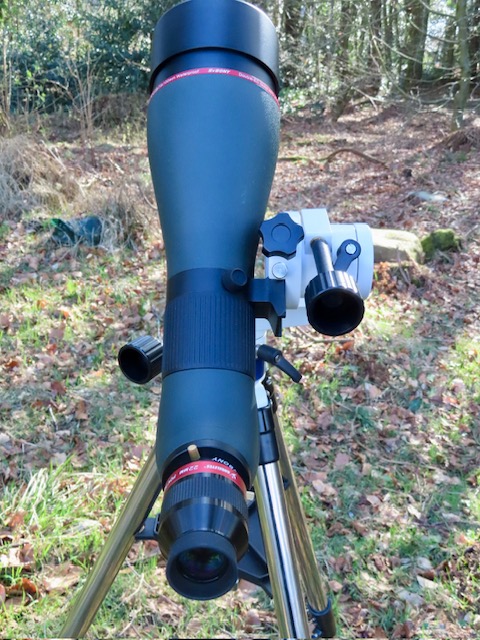
I’ve been experimenting with a few more eyepieces that can be coupled to the instrument. Taking a punt on an ANGELEYES branded 22mm ultra wide angle, I was really impressed with the much wider field of view delivered by this 1.25” eyepiece. On paper this 70 degree AFOV ought to deliver a power of 25x in a 2.8 degree field but the limited diameter of the eyepiece port on the spotting scope reduced this field to somewhere nearer 2.3 degrees. Still, this is a huge improvement over using the dedicated zoom. I use it mostly as a rich field eyepiece to enjoy the glories of the night sky.
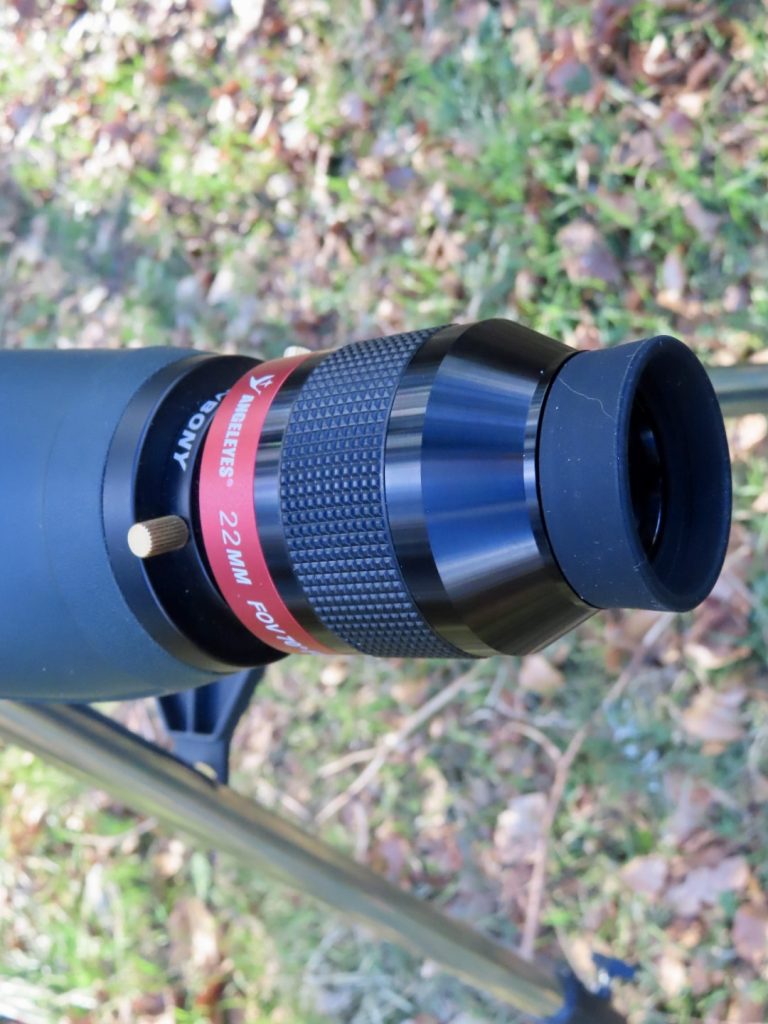
In addition I’ve found the red-label Svbony 15mm eyepiece with its 68 degree AFOV to be an excellent, economical mid power eyepiece delivering a magnification of 37x in a great 1.8 degree field.
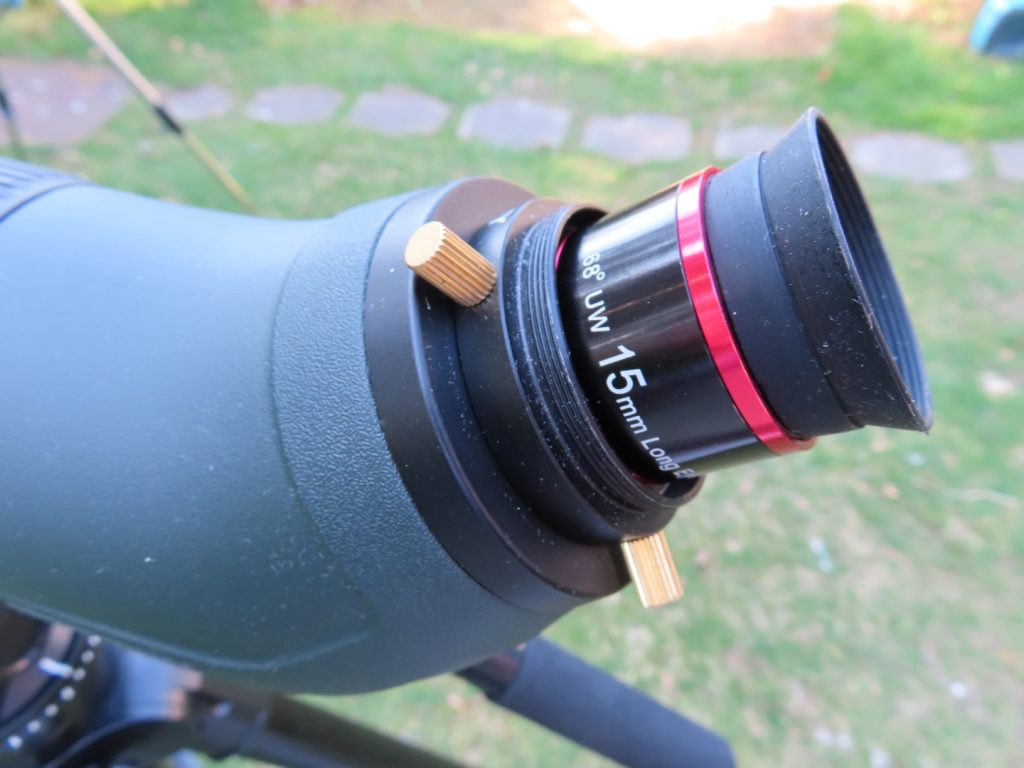
I believe both these eyepieces will greatly enhance the viewing experience with the beautiful SA401 100mm APO spotter. Check them out if you get a chance!
Dr Neil English explores many more bargains in his latest book, Choosing & Using Binoculars: a Guide for Stargazers, Birders and Outdoor Enthusiasts.
.
Hi, I have an Svbony SA401 20-60×85 with an SA 406 adapter. I don’t know much about astronomy and optics, so I need your help choosing which eyepieces from the Svbony line to buy so that they can work here and get large magnifications (120-150x). Thanks a lot in advance.
Hi Dmitri,
I mentioned a few ways of boosting the magnification on the SA401 if you have the thread-on adapter. Short focal length Plossls work well as does the SV 191 7.1-21.6 mm zoom eyepiece with a low profile Barlow lens ahead of it. I have another Svbony eyepiece on order: the 6mm wide angle.Once I get it and let you know if it works on the spotter.
Neil
Hello Dmitri,
I received the Svbony 6mm wide angle eyepiece today. It works great with the SA401 delivering 93x with the 100mm model. And coupled to a 1.6 x Barlow as shown in the review above, it gives a good high power of 148x. I would heartily recommend this eyepiece for these spotting scopes.
Neil.
Thank you very much!
Hello,
I would be interested to know if the focus ring was soft or rather rigid.
Thanks in advance
Paul
Hi Paul,
The focusing ring has just the right amountof tension: not too tight or loose.
Regards,
Neil
Thanks for the good review! I just placed order for the SA401 100mm.
1. Can you please tell me if it would be possible to use a wide angle eyepiece to make wider field of view with this scope at lower magnification? Something like the everyone’s favorite Panoptic 24mm (or a cheaper alternative of 68 degree 24mm eyepiece, and from which manufacturer)?
2. Also will this scope work with Hyperion zoom 8-24mm noticeably better then with the generic one? And will it be able focus at all?
With SA401 x85 version I use UF24 (Sky Rover branded) eyepiece as wide and bright (also sharp) view – it close to the maximum provided linear field (by erecting prism and 1.25 inch mount) and gives about 65 degrees AFOV and good up to 29mm eye relief. Same also available from different brands – Celestron Ultima Edge 24, APM and may be others (no SVBONY copy yet). Also it looks a bit wider in TFOV in comparison with SVBONY super-zoom SV230 and about twice cheaper. Though it is a fix lens and need to switch manually instead of just rotating zoom ring.
Hello Slobodan,
Apologies for the delay but I was actually conducting more investigations on new wide angle options for the SA401.
I can highly recommend the Angel Eyes branded 22mm 70 degree AFOV eyepiece. It delivers a power of 25x with a true field of over 2 degrees. It works beautifully using the 1.25” eyepiece adaptor and is very sharp edge to edge. I picked this up for about £70 from AliExpress.
The other eyepiece is the Svbony red label wide angle(68 degree AFOV) eyepiece. I just received a 15mm unit yielding 37x in a nice wide angle view. Picked that one up for just over £20 from the same source. I will update this shortly at the end of my review.
Still very much enjoying the high quality views of the SA 401 APO spotter!
Best wishes,
Neil
Neil, are both suggested eyepieces also suitable fot birding?
Yes they can be used for birding with the caveat that they are fixed magnification eyepieces.
Neil.
Hello Neal,
that review on Amazon was mine after many months with this the sa401 spotting scope I’m still baffled it still cost under £1,000,I recently bought the 1.25 adapter to use astro fixed Eyepieces including ultra wide 82 degree skywatcher Eyepieces and Baader Hyperion and opticstar premium zoom eyepiece,I have countless Eyepieces and they all work brilliantly and reach focus to infinity which many spotting scopee fail to do.
It’s such a shame that svbony fail to mention that it’s a multi elements objective consisting of four elements with two of them being ED whereas the the Celestron Regal is only a doublet and only one of the element is ED in reality a doublet can’t complete with a well designed triplet let alone a quadruplet which is what the design of thesvbony sa401 with its four elements objectives the scale that the svbony beat the Celestron by is huge.
I really enjoy your comprehensive reviews
Hello Victor,
Many thanks for chiming in. I want to thank you for doing that review on amazon. It was spot on!
I have attached a little finder scope to the side of the SA401 to help pinpoint targets and it works great. Indeed I was out tonight with it admiring the waxing crescent moon.
I absolutely agree with you regarding its optical quality. It’s simply in a different league compared with a typical ED doublet spotter. Definitely a keeper! Hope to get to use it a lot over the summer and load up more images.
Have fun with your SA 401!
Kind Regards,
Neil.
Hello again, Neil.
Could you please post photos of the SA401 with the “little finder” installed. Which finder, Rigel? I also want to install a finder on my pipe, but alas, Rigel is not available in Russia. And something else is either very large for my pipe (20-60×85), or I haven’t figured out how to install it yet, it’s difficult to attach it somehow (maybe just wrap it?). Maybe after seeing how you did it, I’ll have some ideas.
Hey, your review got me to buy this amazing scope. The image quality is amazing and it got me wondering if i could take it any further and improve upon this scope. So i bought the recently released SA406 adapter for the SV230 super zoom eyepiece(svbony’s premium zoom eyepiece of around 300 euros). This SA406 is not the same adapter they produced a year or so ago, it’s actually a brand new adapter specifically for the sv230 and sv245 eyepieces. And let me tell you it’s amazing, the brightness, contrast and sharpness as well as clarity and color vividness have all improved compared to the original eyepiece. It turned a very good scope to an absolute premium spotting scope. The issue with the narrow afov has also been solved since the sv230 has a 57 afov at 20mm and 72-75 afov at 8mm. Im going to try a Barlow lens on this configuration to see if i can push the magnification even further! If anyone has this scope they should seriously consider making this investment
Hi Christian, I also purchased this wonderful spotting scope and the sv230 eyepiece with the sa406 adapter. I would like to know how you have been using the barlow lenses?
Hi, very good and useful review!
I bought this scope (in 85mm) and must say I’m impressed with the build and optical quality.
Unfortunately I don’t have the adapter for 1.25 eyepieces, so i was wondering if any of you could recommend an alternative adapter. I saw that the stock zoom eyepiece has an internal thread that measures about 4.2 mm in diameter so it could be a m42 but i’m not sure…
Hi, thanks for this beautiful and very useful review.
I own the 85mm model and must say I’m very impressed with build and optical quality.
Unfortunately i don’t have the adapter for 1.25 eyepieces, and the shipping time from China for the SA406 is very long, so i was wondering if any of you could recommend an alternative 3rd party adapter that could possibly work.
I saw that the zoom eyepiece has an internal thread that measures about 4.2 mm in diameter so it could be a m42 but i’m not sure…
Hi Valerio,
Thanks for your feedback. Unfortunately, I don’t know of any other adaptor apart from Svbony’s that can do this job.
Regards,
Neil
Hi, Neil!
Another great review, thanks! How to choose between 85mm and 100mm versions? When do you think the extra weight, lenght and price are justified?
Hello Kunter,
Thanks for your message and compliments. In general the 85mm scope works well in good light and moderate magnifications. But if you are dealing with low light situations, the extra light grasp of the 100mm comes into its own. The other thing a larger scope can do is to enjoy higher powers so has greater range under ideal conditions.
Regards,
Neil
Hello,
I have configured the SA401 spotting scope for ornithological observations and that will be its main purpose.
In addition, with such good optics there is also the possibility of astronomical observations. However, this sometimes requires higher magnification.
Since the zoom eyepiece 3 – 8 mm (SV215) unfortunately doesn’t fit due to its design, I’m looking for another way to achieve higher magnifications. It seemed sensible to me to combine the existing, very good eyepiece (SV230) with a Barlow lens (SV216, 2x).
Unfortunately, Svbony wrote to me that this combination doesn’t work.
Are there really “only” eyepieces with fixed focal lengths left?
Thank you very much for your answer!
Frank
Hi Frank,
I listed a number of eyepieces that can be used with the SA 401 spotter. I too was disappointed when I couldn’t use their 3-8mm zoom on the telescope. It would have been ideal for higher power astronomical use.
I think it just comes with the territory when you design these scopes for terrestrial use.
Regards,
Neil.
Hello.
I screw the Barlow SV137 lens onto the SV230 eyepiece and get about a 100x.
Ich besitze das SV406P ED undSC001und frage mich, ob das die camera SC311 nicht auch kompatibel und geeignet ist mit dem Spectiv astromomische Sichten möglich sind. Weiss da jemand Bescheid?
Fantastic review Neil
I purchased the SA401 after reading your review. But the SA401 doesn’t appear to be compatible with 2” eyepieces that are push-fit. I took the SA401 to a local astronomy store with the intention of replacing the supplied zoom eyepiece with a 2” eyepiece that features an UWA. The store supplied 2” eyepieces that were push fit so they wouldn’t fit the 2” threaded connection on the SA401 scope.
I don’t suppose you have a solution?
Hi Stuart,
Thanks for your feedback. Unfortunately I don’t know of any 2-inch eyepieces that can be used with the SA 401 spotting scope. The widest I’ve achieved was to use a 22mm UWA (70 degree AFOV) with that instrument. But it’s still a 1.25” format.
Regards,
Neil.
Auch Dank von mir für deine Rezension.
Du hast mich jedoch gewaltig in die Klemme gebracht betreffs Auswahl.
Meine Anwendung ist hauptsächlich die Tierbeobachtung und Fotos bei Tageslicht. Der Himmel ist bei mir nur eine Randeerscheinung.
Das 401 25-75×100 besticht wirklich nach allem was ich bisher in Erfahrung bringen konnte.
Doch das 401 20-60×85 kommt für mich aufgrund des Gewichtsunterschiedes auch in Frage. ????????????????????